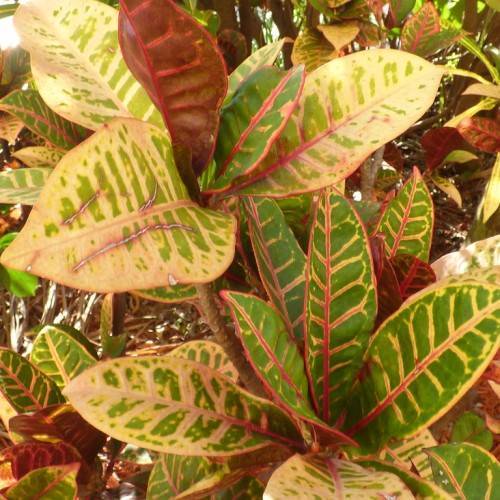
croton
Codiaeum variegatum
Cycle:
Perennial
Watering:
Average
Hardiness Zone:
11 - 12
Flowers:
Flowers
Sun:
part shade,full sun
Leaf:
Yes
Growth Rate:
Low
Maintenance:
Moderate
Poisonous To Pets:
Yes
Salt Tolerant:
Yes
Tropical:
Yes
Indoors:
Yes
Care Level:
Medium
watering
Crotons should be watered when the top inch or 2 of soil feels dry to the touch. It's best to water deeply and then allow the soil to dry out completely before watering again. Generally, crotons should be watered about once a week, or when the top 1 to 2 inches of soil feels dry. Be careful not to overwater the plant as this can lead to issues such as root rot.
sunlight
The croton plant species (Codiaeum variegatum) does best when it is receiving 6 to 8 hours of bright but indirect sunlight each day. This can be best achieved by placing the plant in a location where it receives sun for most of the day with a few hours of shade for a break in the light. It is important not to place the plant in direct sunlight, as this can burn the leaves.
pruning
Croton (Codiaeum variegatum) should be pruned at least once a year for general maintenance. Pruning should be done quite aggressively in order to keep the croton looking nice and to ensure that the plant materials are not growing too large. When pruning, it is important to remember that all branches, stems, and foliage should not be cut back more than 1-third of their original size. This will ensure that the plant does not suffer too much stress from pruning and will keep the plant's form and look its best for the long term. Croton is an evergreen shrub and can be kept pruned to a desired height or shape. It's best to do pruning during the warmer months (April-October) when the plant is most actively growing.
Season
Hardiness Map
FAQ
How toxic are croton plants to pets?
Croton plants are toxic to pets if ingested. The plant contains toxins that can cause vomiting, excessive drooling, and upset stomach as soon as 15 minutes after ingestion. If ingested, seek medical attention for your pet as soon as possible. Signs of poisoning may be difficult to identify and may require extensive medical treatments. Since these plants are toxic, it is important to keep them away from pets and children in the home.
Can croton plants bloom indoors?
Yes, croton plants can bloom indoors. They like bright, indirect light, so it is important to place them where they can get plenty of sunlight that is not too direct. They also need moist, well-draining soil and should be watered regularly. Additionally, these plants are susceptible to several pests, so it is important to check them periodically and examine any discolored leaves. With the right conditions, croton plants can provide colorful and vibrant blooms indoors.
Are low light conditions suitable for croton plants?
Low light conditions are acceptable for croton plants in moderation. Depending on the type of croton and how much light it needs, it can survive in low light conditions. If a croton plant is in a low light environment, it can reach health and growth, but it will not thrive. The foliage of croton plants will not be as vibrant and colorful when they are in low light conditions, so it’s important to adjust the environment accordingly. Be sure to give your croton plenty of bright, indirect sunlight to help it thrive.
How often should you water croton plants?
Croton plants typically require consistently moist soil, so you should water them when the top 1-2 inches of soil has dried out. Depending on the size of the pot, weather, and other factors, this could mean watering every 2-4 days. Additionally, it can be beneficial to mist the leaves of the plant with water to provide additional humidity, which may need to be done once or twice a week.
